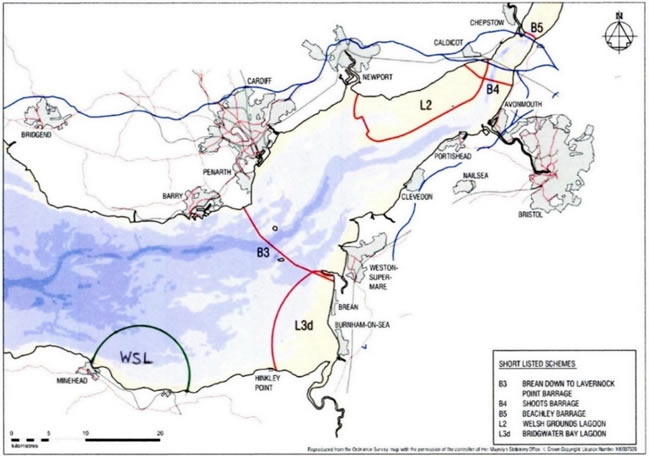Location and Scheme Description
West Somerset Lagoon (WSL) is a proposed Tidal Range power scheme in the Bristol Channel. The Bristol Channel/Severn Estuary has the second highest tidal range in the world. The lagoon will be located off the coast of West Somerset between Minehead and Watchet. The enclosure is a semi-circular D-shape as that is the most cost-effective shape. It has a diameter of 14km, an overall perimeter 22km and it will enclose an area of about 80km2. The proposed location is downstream of the Severn Estuary areas with special environmental designations (SACs & SPAs). The lagoon will not contain any large rivers, although it will contain four streams. The lagoon is outside the main shipping channels, which largely run up the deep-water channel off the Welsh coast, thus there should be minimal direct impact on shipping. Commercial activity within the basin is limited to a few small fishing boats and one occasional tourist vessel. Thus this is an excellent site for a tidal range energy scheme. The map below shows the location for WSL (in green) superimposed on a diagram taken from the DECC report of 2010 on options for tidal range schemes in the Bristol Channel / Severn Estuary.

WSL will generate electricity on both ebb (falling) and flood (rising) tides. Also, the generators can be used as pumps to increase high water levels and lower low water levels, mainly on Neap tides. This will result in high and low water levels within the lagoon area broadly similar to existing for Spring tides and for Neap tides, somewhat higher and lower than existing.
The energy output from WSL has been estimated to be 6.5 TWh per year, which is around two thirds of the current domestic electrical consumption in the South West region. The energy estimate is based on modelling carried out by the Hydro-environmental Research Centre at Cardiff University. This started with modelling of a range of installed power capacities which allowed TEES to determine the most cost effective scheme as one with a capacity of 2500MW and an economic amount of sluice capacity. That preferred scheme was then modelled in more detail to provide the energy estimate of 6.5 TWh per year and also predicted water velocities and levels both inside and outside the lagoon.
The periods without generation are around 2 hours on spring tides and 4 hours on neap tides. Because these times are totally predictable, firm power could be provided with the use of storage. The most appropriate form and amount of storage is under investigation.